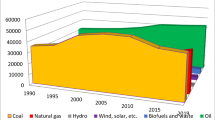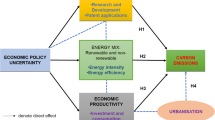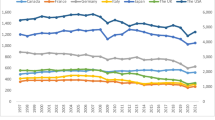Abstract
The well-established emissions-growth debate relies on the symmetric nexus between CO2 emissions and economic growth, thereby ignoring a fundamental component of macro economy in the form of asymmetric relation. This paper considers how CO2 emissions respond asymmetrically to changes in economic growth. While utilizing both linear and nonlinear time series approaches for an environmentally exposed country, Pakistan over the period 1971–2018, we find convincing evidence that CO2 emissions rise more rapidly during negative shocks to economic growth than increase during economic expansions. Thus, contrary to what has previously been reported, the effect is strong as holds both at short run and long run. This is partly due to the increase in informal sector as GDP declines. Our estimated results show that accounting for the shadow economy results a higher magnitude of CO2 emissions due to decrease in economic growth, thus question the traditional symmetric decoupling of economic growth and CO2 emissions. The estimated results are robust to alternative estimators such as fully modified least squares (FMOLS) and dynamic OLS (DOLS). Thus, the findings of this study call for a re-thinking on climate policy design that rarely pays attention to the aforementioned outcomes due to fall in economic growth.




Similar content being viewed by others
Notes
As evidenced in the second half of 2013 that due to economic contraction, CO2 emissions hit the lowest level as that of 1994 in the USA.
Shadow economy (also known as informal, black, unofficial or underground economy) exhibits the alternative side of the dual economy structure such as the existence of economic activities outside the purview of the national authorities. For the plethora of the concepts, definitions and the related measurements methods of shadow economy (see Bajada 1999; Caridi and Passerini 2001; Schneider 2016; Schneider and Enste 2000).
There are some studies investigating EKC hypothesis in Pakistan include (see for instance, Shahbaz et al. 2012; Ahmed and Long 2013; Mehmood et al. 2013; Javid and Sharif 2016; Baloch et al. 2018) while numerous studies have worked out on the traditional sources of environmental pollution (see, Ahmed and Long 2012; Shahbaz 2013; Munawar et al. 2015; Baloch et al. 2018).
Considering the concerned limitations of the various measures, we prefer to use the aforementioned shadow economy index which uses the dynamic multiple indicators multiple causes (DYMIMIC) that is commonly preferred method in the literature.
References
Abid M (2014) Energy consumption-informal economic growth analysis: what policy options do we have? J Knowl Econ 7(1):207–218. https://doi.org/10.1007/s13132-014-0211-x
Abid M (2015) The close relationship between informal economic growth and carbon emissions in Tunisia since 1980: the (ir)relevance of structural breaks. Sustain Cities Soc 15:11–21. https://doi.org/10.1016/j.scs.2014.11.001
Abid M (2016) Size and implication of informal economy in african countries: evidence from a structural model. Int Econ J 30(4):571–598. https://doi.org/10.1080/10168737.2016.1204342
Ahmed K, Long W (2012) environmental kuznets curve and Pakistan: an empirical analysis. Procedia Econ Finance 1(12):4–13. https://doi.org/10.1016/S2212-5671(12)00003-2
Ahmed K, Long W (2013) An empirical analysis of CO2 emission in Pakistan using EKC hypothesis. J Int Trade Law Policy 12(2):188–200. https://doi.org/10.1108/JITLP-10-2012-0015
Ahmed K, Shahbaz M, Qasim A, Long W (2015) The linkages between deforestation, energy and growth for environmental degradation in Pakistan. Ecol Indic 49(2014):95–103. https://doi.org/10.1016/j.ecolind.2014.09.040
Apergis N, Payne JE (2009) CO2 emissions, energy usage, and output in Central America. Energy Policy 37(8):3282–3286. https://doi.org/10.1016/j.enpol.2009.03.048
Arby MF, Malik MJ, Hanif MN (2012) The size of informal economy in Pakistan. Finance Res 1(2):11–18
Bajada C (1999) Estimates of the underground economy in Australia. Econ Rec 75(4):369–384. https://doi.org/10.1111/j.1475-4932.1999.tb02573.x
Bajada C, Schneider F (2005) The shadow economies of the Asia-Pacific. Pac Econ Rev 10(3):379–401. https://doi.org/10.1111/j.1468-0106.2005.00280.x
Baksi S, & Bose P (2010) Environmental regulation in the presence of an informal sector. University of Winnipeg Department of Economics Working Paper, 3. Retrieved from ftp://ftp.repec.org/opt/ReDIF/RePEc/win/winwop/2010-03.pdf
Baloch A, Shah SZ, Noor ZM, Magsi HB (2018) The nexus between income inequality, economic growth and environmental degradation in Pakistan. GeoJournal 83(2):207–222. https://doi.org/10.1007/s10708-016-9766-3
Banerjee A, Dolado J, Mestre R (1998) Error-correction mechanism tests for cointegration in a single-equation framework. J Time Ser Anal 19(3):267–283. https://doi.org/10.1111/1467-9892.00091
Bayar Y, Ozturk OF (2014) Financial development and shadow economy in European union transition economies. Manag Global Trans 14(2):157–173
Bernard JT, Gavin M, Khalaf L, Voia M (2014) Environmental Kuznets curve: tipping points, uncertainty and weak identification. Environ Resour Econ 60(2):285–315. https://doi.org/10.1007/s10640-014-9767-y
Biswas AK, Farzanegan MR, Thum M (2012) Pollution, shadow economy and corruption: theory and evidence. Ecol Econ 75:114–125. https://doi.org/10.1016/j.ecolecon.2012.01.007
Buehn A, Schneider F (2012) Corruption and the shadow economy: Like oil and vinegar, like water and fire? Int Tax Public Financ 19(1):172–194. https://doi.org/10.1007/s10797-011-9175-y
Burke PJ, Shahiduzzaman M, Stern DI (2015) Carbon dioxide emissions in the short run: The rate and sources of economic growth matter. Glob Environ Chang 33:109–121
Caridi P, Passerini P (2001) The underground economy, the demand for currency approach and the analysis of discrepancies: Some recent European experience. Rev Income Wealth 47(2):239–250. https://doi.org/10.1111/1475-4991.00014
Chaudhuri S, Mukhopadhyay U (2006) Pollution and informal sector: and theoretical analysis. J Econ Integr 21(2):363–378. https://doi.org/10.2307/23000617
Dickey D, Fuller W (1979) Distribution of the estimators for autoregressive time series with a unit root. J Am Stat Assoc 74(366):427–431. https://doi.org/10.2307/2286348
Din BH, Habibullah MS, Baharom AH, Saari MD (2016) Are shadow economy and tourism related? International evidence. Procedia Econ Finance 35(October 2015):173–178. https://doi.org/10.1016/S2212-5671(16)00022-8
Dinda S, Coondoo D, Pal M (2000) Air quality and economic growth: an empirical study. Ecol Econ 34(3):409–423. https://doi.org/10.1016/S0921-8009(00)00179-8
Doda, B. (2013). Emissions-GDP Relationship in Times of Growth and Decline (No. Working Paper).
Doda B (2014) Evidence on business cycles and CO2 emissions. J Macroecon 40:214–227. https://doi.org/10.1016/j.jmacro.2014.01.003
Dreher A, Schneider F (2010) Corruption and the shadow economy: an empirical analysis. Public Choice 144(1–2):215–238. https://doi.org/10.1007/s11127-009-9513-0
Elgin C, & Öztunalı O (2012) Shadow economies around the world: model based estimates. Working Papers 2012/05, Bogazici University, 48. Retrieved from https://ideas.repec.org/p/bou/wpaper/2012-05.html
Eng Y-K, Wong C-Y (2017) Tapered US carbon emissions during good times: what’s old, what’s new? Environ Sci Pollut Res 24(32):25047–25060. https://doi.org/10.1007/s11356-017-0144-6
Eng Y, & Wong C (2015) Toward a decarbonizing economic expansion: evidence from nonlinear Ardl approach. Retrieved from http://staff.utar.edu.my/wongcy/default_files/manuscript.pdf
Engle RF, Granger CWJ (1987) Co-integration and error correction: representation, estimation, and testing. Econometrica 55(2):251–276. https://doi.org/10.2307/1913236
Ericksen PJ (2008) Conceptualizing food systems for global environmental change research. Glob Environ Chang 18(1):234–245. https://doi.org/10.1016/j.gloenvcha.2007.09.002
Farzin YH, Bond C a (2005) Democracy and environmental Quality. J Dev Econ 81:213–235. https://doi.org/10.1016/j.jdeveco.2005.04.003
Feige EL, Urban I (2008) Measuring underground (unobserved, non-observed, unrecorded) economies in transition countries: can we trust GDP? J Comp Econ 36(2):287–306. https://doi.org/10.1016/j.jce.2008.02.003
Friedl B, Getzner M (2003) Determinants of CO2 emissions in a small open economy. Ecol Econ 45(1):133–148. https://doi.org/10.1016/S0921-8009(03)00008-9
Gasparini L, Tornarolli L, Ghosh T, Anderson SJ, Powell RLRRL, Sutton PC et al (2010) New estimates for the shadow economies all over the world. Int Econ J 24(2):443–461. https://doi.org/10.1080/10168737.2010.525974
Goel RK, Saunoris JW (2014a) Global corruption and the shadow economy: spatial aspects. Public Choice 161(1–2):119–139. https://doi.org/10.1007/s11127-013-0135-1
Goel RK, Saunoris JW (2014b) Military versus non-military government spending and the shadow economy. Econ Syst 38(3):350–359. https://doi.org/10.1016/j.ecosys.2013.12.004
Habibullah MS, Din BH, Yusof-Saari M, & Baharom AH (2016) Shadow economy and financial sector development in Malaysia. Int J Econ Financ Issues, 6(7Special Issue).
Hao Y, Chen H, Zhang Q (2016) Will income inequality affect environmental quality? Analysis based on China’s provincial panel data. Ecol Indic 67:533–542. https://doi.org/10.1016/j.ecolind.2016.03.025
Heutel G (2012) How should environmental policy respond to business cycles? Optimal policy under persistent productivity shocks. Rev Econ Dyn 15(2):244–264. https://doi.org/10.1016/j.red.2011.05.002
IEA (2015) India energy outlook 2015. IEA, Paris. https://www.iea.org/reports/india-energy-outlook-2015
IPCC (2013) Climate change 2013: the physical science basis. In: Stocker TF, Qin D, Plattner G-K, Tignor M, Allen SK, Boschung J, Nauels A, Xia Y, Bex V, Midgley PM (eds) Contribution of working group I to the fifth assessment report of the intergovernmental panel on climate change. Cambridge University Press, Cambridge and New York
Jaunky VC (2011) The CO2 emissions-income nexus: Evidence from rich countries. Energy Policy 39(3):1228–1240. https://doi.org/10.1016/j.enpol.2010.11.050
Javid M, Sharif F (2016) Environmental Kuznets curve and financial development in Pakistan. Renew Sust Energ Rev 54:406–414. https://doi.org/10.1016/j.rser.2015.10.019
Johansen S, Juselius K (1990) Maximum likelihood estimation and inference on cointegration- with applications to the demand for money. Oxf Bull Econ Stat 52(2):169–210. https://doi.org/10.1111/j.1468-0084.1990.mp52002003.x
Jorgenson AK, Clark B (2012) Are the Economy and the Environment Decoupling? A Comparative International Study, 1960–2005. Am J Sociol 118(1):1–44. https://doi.org/10.1086/665990
Jotzo F, Burke PJ, Wood PJ, Macintosh A, Stern DI (2012) Decomposing the 2010 global carbon dioxide emissions rebound. Nat Clim Chang 2(4):213–214. https://doi.org/10.1038/nclimate1450
Kar S, Saha S (2012) Corruption, Shadow Economy and Income Inequality: Evidence from Asia. IZA Discussion Paper 7106:1–31
Köksal C, Işik M, Katircioğlu S (2020) The role of shadow economies in ecological footprint quality: empirical evidence from Turkey. Environ Sci Pollut Res 27:1–10. https://doi.org/10.1007/s11356-020-07956-5
Kraft, J., & Kraft, A. (1978). On the relationship between energy and GNP. Journal of Energy and Development, 3, 401–403. 6713220
Lewis, A. (1954). Economic development with unlimited supplies of labour. Manchester School of Economic and Social Studies, 23
Mak Arvin B, Lew B (2011) Does democracy affect environmental quality in developing countries? Appl Econ 43(August 2014):1151–1160. https://doi.org/10.1080/00036840802600277
Mazhar U, Elgin C (2013) Environmental regulation, pollution and the informal economy. SBP Res Bull 9(1):62–81 Retrieved from http://www.sbp.org.pk/research/bulletin/2013/Vol-9-1/Environmental Regulation, Pollution and the Informal Economy.pdf
Mehmood B, Muhammad T, Mateen M (2013) Environmental Kuznets curve: a multi-proximal approach for Pakistan. Empirical Econ Lett 12(6):629–642
Munawar S, Khokhar MF, Atif S (2015) Reducing emissions from deforestation and forest degradation implementation in northern Pakistan. Int Biodeterior Biodegradation 102:316–323. https://doi.org/10.1016/j.ibiod.2015.02.027
Narayan PK (2005) The saving and investment nexus for China: evidence from cointegration tests. Appl Econ 37(17):1979–1990. https://doi.org/10.1080/00036840500278103
Narayan PK, Narayan S (2010) Carbon dioxide emissions and economic growth: panel data evidence from developing countries. Energy Policy 38(1):661–666. https://doi.org/10.1016/j.enpol.2009.09.005
Narayan PK, Narayan S, Smyth R (2011) Energy consumption at business cycle horizons: The case of the United States. Energy Econ 33(2):161–167. https://doi.org/10.1016/j.eneco.2010.06.007
Nkengfack H, Fotio HK, Totouom A (2020) How does the shadow economy affect environmental quality in Sub-Saharan Africa? Evidence from heterogeneous panel estimations. J Knowl Econ:1–17. https://doi.org/10.1007/s13132-020-00685-7
Panayotou T (1997) Demystifying the environmental Kuznets curve: turning a black box into a policy tool. Environ Dev Econ 2(4):465–484. https://doi.org/10.1017/S1355770X97000259
Pesaran MH, Shin Y (1999) An autoregressive distributed-lag modelling approach to cointegration analysis. In: Strom S (ed) Econometrics and Economic Theory in the 20th Century, vol 31. Cambridge University Press, Cambridge, pp 371–413. https://doi.org/10.1017/CCOL521633230.011
Pesaran MH, Shin Y, Smith RJ (2001a) Bounds testing approaches to the analysis of level relationships. J Appl Econ 16(3):289–326. https://doi.org/10.1002/jae.616
Pesaran MH, Shin Y, Smith RJ (2001b) Bounds testing approaches to the analysis of long run relationships. J Appl Econ 16:289–326. https://doi.org/10.1002/jae.616
Peters G, Marland G, Le Quéré C, Boden T, Canadell JG, Raupach MR (2011) Rapid growth in CO2 emissions after the 2008–2009 global financial crisis. Nat Clim Chang 2(January):2–4. https://doi.org/10.1038/nclimate1332
Phillips PP, Perron P (1988) Testing for a unit root in time series regressions. Biometrika 75(2):335–346 Retrieved from http://www.ssc.wisc.edu/~bhansen/718/PhillipsPerron1988.pdf
Schneider F (2016) Estimating the size of the shadow economy: methods, problems and open questions. Turkish Econ Rev 3(2):256–280. https://doi.org/10.1453/ter.v3i2.832
Schneider, F., Buehn, A., & Schneider, F. (2009). Shadow economies and corruption all over the world : revised estimates for 120 countries. The Open-Access, Open-Assessment E-Journal, 1(2007–9), 0–53. https://doi.org/10.5018/economics-ejournal.ja.2007-9
Schneider F, Enste DH (2000) Shadow economies: size, causes, and consequences. J Econ Lit 38(1):77–114. https://doi.org/10.1257/jel.38.1.77
Schneider F, Raczkowski K, Mróz B, Schneider F, Raczkowski K (2015) Shadow economy and tax evasion in the EU. J Money Laund Cont 18(1):34–51. https://doi.org/10.1108/JMLC-09-2014-0027
Shahbaz M (2013) Does financial instability increase environmental degradation? Fresh evidence from Pakistan. Econ Model 33:537–544. https://doi.org/10.1016/j.econmod.2013.04.035
Shahbaz M, Lean HH, Shabbir MS (2012) Environmental Kuznets curve hypothesis in Pakistan: cointegration and Granger causality. Renew Sust Energ Rev 16(5):2947–2953. https://doi.org/10.1016/j.rser.2012.02.015
Sheldon TL (2017) Asymmetric effects of the business cycle on carbon dioxide emissions. Energy Econ 61:289–297. https://doi.org/10.1016/j.eneco.2016.11.025
Shin Y, Yu B, Greenwood-Nimmo M (2014) Modelling asymmetric cointegration and dynamic multipliers in a nonlinear ARDL framework. In Festschrift in Honor of Peter Schmidt (pp. 281-314). Springer New York. The Festschrift in Honor of Peter Schmidt. https://doi.org/10.1007/978-1-4899-8008-3
Soytas U, Sari R, Ewing BT (2007) Energy consumption, income, and carbon emissions in the United States. Ecol Econ 62(3–4):482–489. https://doi.org/10.1016/j.ecolecon.2006.07.009
Stern DI (2004) The rise and fall of the environmental Kuznets curve. World Dev 32(8):1419–1439. https://doi.org/10.1016/j.worlddev.2004.03.004
Tamazian A, Bhaskara Rao B (2010) Do economic, financial and institutional developments matter for environmental degradation? Evidence from transitional economies. Energy Econ 32(1):137–145. https://doi.org/10.1016/j.eneco.2009.04.004
Tamazian A, Chousa JP, Vadlamannati KC (2009) Does higher economic and financial development lead to environmental degradation: evidence from BRIC countries. Energy Policy 37(2009):246–253. https://doi.org/10.1016/j.enpol.2008.08.025
Torras M, Boyce JK (1998) Income, inequality, and pollution: a reassessment of the environmental Kuznets curve. Ecol Econ 25(2):147–160. https://doi.org/10.1016/S0921-8009(97)00177-8
Wang Q, Chiu YH, Chiu CR (2015) Driving factors behind carbon dioxide emissions in China: a modified production-theoretical decomposition analysis. Energy Econ 51:252–260. https://doi.org/10.1016/j.eneco.2015.07.009
York R (2012) Asymmetric effects of economic growth and decline on CO2 emissions. Nat Clim Chang 2(11):762–764. https://doi.org/10.1038/nclimate1699
Zhang YJ, Liu Z, Zhang H, Tan TD (2014) The impact of economic growth, industrial structure and urbanization on carbon emission intensity in China. Nat Hazards 73(2):579–595. https://doi.org/10.1007/s11069-014-1091-x
Author information
Authors and Affiliations
Contributions
Said Zamin Shah, the corresponding author of this research manuscript initiated the research idea. He and Amdad Ullah analyzed and interpreted the data. Balach Rasheed contributed by writing review of literature. Muzafar Shah contributed by arranging and checking the manuscript.
Corresponding author
Ethics declarations
Competing interests
The authors declare that they have no competing interests.
Additional information
Responsible Editor: Eyup Dogan
Publisher’s note
Springer Nature remains neutral with regard to jurisdictional claims in published maps and institutional affiliations.
Rights and permissions
About this article
Cite this article
Baloch, A., Shah, S.Z., Habibullah, M.S. et al. Towards connecting carbon emissions with asymmetric changes in economic growth: evidence from linear and nonlinear ARDL approaches. Environ Sci Pollut Res 28, 15320–15338 (2021). https://doi.org/10.1007/s11356-020-11672-5
Received:
Accepted:
Published:
Issue Date:
DOI: https://doi.org/10.1007/s11356-020-11672-5




